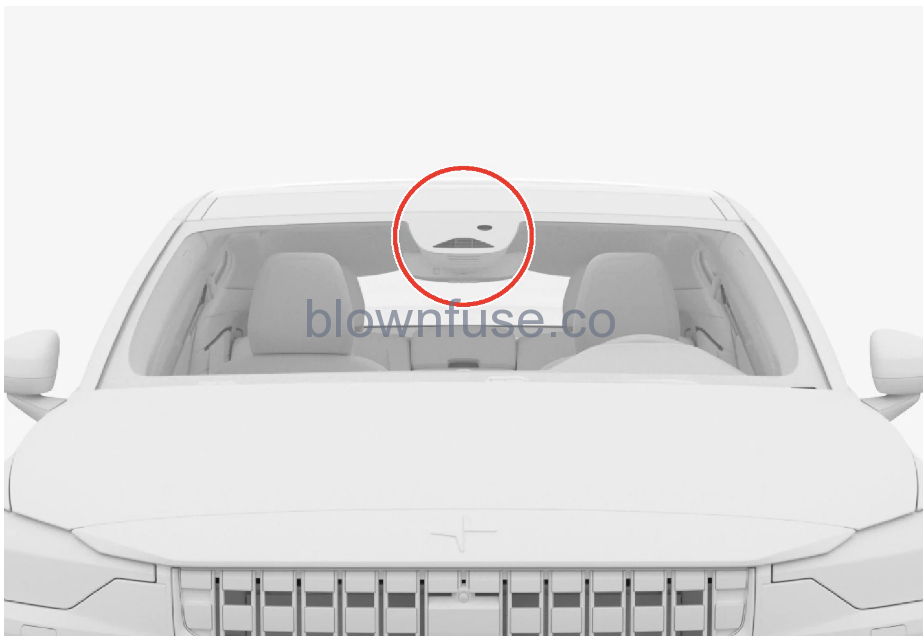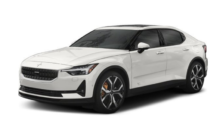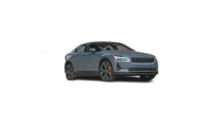

Location of the camera
The camera is used by the following functions:
- Adaptive Cruise Control*
- Pilot Assist *
- Lane Keeping Aid
- Assistance during collision risks
- Driver Alert Control
- Traffic sign information (This function is available in certain markets).
- Active high beam
- Park Assist System
- Ready to drive notification
Camera limitations
Failure to take action could result in reduced performance for the driver support systems that use the camera unit. It could cause functions to be reduced, deactivated completely or to produce an incorrect function response.
To avoid the risk of malfunction of the driver support systems that use the camera, the following also apply:
- If there are cracks, scratches or stone chips on the windshield in front of any of the camera “windows” and this covers an area of about 0.5×3.0 mm (0.02×0.12 inches) or more, contact Polestar Customer Support to have the windshield replaced.
- Polestar advises against repairing cracks, scratches or stone chips in the area in front of the camera – the entire windshield should instead be replaced.
- Before replacing the windshield, contact Polestar Customer Support to verify that the right windshield has been ordered and installed.
- The same type of windshield wipers or wipers approved by Polestar should be used for replacement.
- If the windshield is replaced, the camera must be recalibrated by a workshop to help ensure proper functioning of all of the vehicle’s camera-based systems. Contact Polestar Customer Support.
Strong sunlight, reflections from the road surface, ice or snow covering the road, a dirty road surface, or unclear lane marker lines may drastically reduce the camera’s ability to detect the side of a lane, a pedestrian, a cyclist, a large animal or another vehicle.
Bicycle holders or other extras mounted behind the vehicle may obstruct the camera’s view.
There are “blind” sectors between the cameras’ fields of vision.
With the Park Assist Camera’s 360° view selected, objects/obstacles may not be detected if they are located in the “joints” where the edges of the individual camera views meet.
Even if it seems as though only a fairly small section of the screen image is obstructed, this may mean that a relatively large sector is hidden and an obstacle there may not be detected until it is very near the vehicle.
Camera symbols and messages
If this symbol and the message “Windscreen sensor blocked See Manual” are displayed in the instrument panel, it means that the camera is unable to detect other vehicles, cyclists, pedestrians and large animals in front of the vehicle and that the vehicle’s camera-based functions may be obstructed.
The following table shows some of the situations that can cause the message to be displayed, and suggested actions:
| Cause | Action |
|---|---|
| The area of the windshield in front of the camera is dirty or covered by ice or snow. | Clean the windshield in front of the camera and remove dirt, ice and snow. |
| Thick fog, heavy rain or snow is blocking the camera’s range of visibility. | No action. Heavy precipitation may sometimes prevent the camera/radar sensor from functioning. |
| Water or snow is spraying/swirling up and blocking the camera’s range of visibility. | No action. Very wet or snow-covered roads may sometimes prevent the camera/radar sensor from functioning. |
| Dirt has collected between the inside of the windshield and the camera. | The windshield on the inside of the camera casing needs to be cleaned – contact Polestar Customer Support. |
| Bright sunlight. | No action. The camera/radar sensor will reset automatically when lighting conditions improve. |
Radar sensor limitations
The camera and radar are intelligent driving aids that cannot be relied on to achieve intelligent driving, and the necessary safety steering must be employed to avoid road safety risks or accidents caused by the driver’s improper use of camera and radar.
Wet snow or ice on the grille in front of the radar unit can disrupt radar-based functions. It could cause functions to be reduced, deactivated completely or to produce an incorrect function response. The driver is always responsible for intervening in this type of situation and for maintaining a safe speed and distance to the vehicle ahead.
The radar sensor’s field of vision
- The radar sensor’s detection of vehicles very close to your vehicle may be delayed in certain situations, e.g. if a vehicle pulls in between your vehicle and the vehicle directly ahead.
- Small vehicles, such as motorcycles, or vehicles that are not driving in the center of the lane may remain undetected.
- In curves, the radar may detect a different vehicle or lose sight of a target vehicle.
Do not install anything in front of the radar unit, such as auxiliary lights, decals, etc., as this could interfere with radar-based functions. It could cause functions to be reduced, deactivated completely or to produce an incorrect function response.
Radar sensor symbols and messages
If this symbol and the message Radar sensor front Sensor blocked See Manual are displayed in the instrument panel, it means that the radar sensor is unable to detect other vehicles, cyclists, pedestrians and large animals in front of the vehicle and that the vehicle’s radar-based functions may be obstructed.
The following table shows some of the situations that can cause the message to be displayed, and suggested actions:
| Cause | Action |
|---|---|
| The area in front of the radar sensor is dirty or covered by ice or snow. | Clean the area in front of the radar sensor. |
| Heavy rain or snow is blocking the radar signals. | No action. Heavy precipitation may sometimes prevent the camera/radar sensor from functioning. |
| Water or snow is spraying/swirling up and blocking the radar signals. | No action. Very wet or snow-covered roads may sometimes prevent the camera/radar sensor from functioning. |
| Market | ACC & PA | BLIS | Type approval |
|---|---|---|---|
| Canada | ✓ | IC: 8436B-77V12FLR | |
| ✓ | Canada Standard RSS-310 | ||
| USA | ✓ | FCC ID: WU877V12FLR | |
| ✓ | FCC ID: NBG01RS4 |
(1) This device may not cause interference.
(2) This device must accept any interference, including interference that may cause undesired operation of the device.
CAUTION TO USERS
Changes or modifications not expressly approved by the party responsible for compliance could void the user`s authority to operate the equipment.
For detailed information on type approval, contact Polestar Customer Support.
Radar units
Location of front radar sensor
Modifying the radar units can make them illegal to use.
Do not mount auxiliary lights or similar in front of the grille as this can affect the radar unit’s functionality.
Recommended maintenance for radar units and parking sensors
It is important that the surfaces in front of radar units and sensors are kept clean. Do not attach any objects, tape or decals to the surface of the sensors.
Location of front radar sensor
Location of rear radar sensor
Location of the Park Assist sensors
Dirt, ice, and snow covering the sensors could cause false warnings, reduced function, or no function.
Only a workshop may perform maintenance on driver support components – contact Polestar Customer Support.
Recommended maintenance for the camera
Dirt, ice, and snow covering the sensors could cause false warnings, reduced function, or no function.
The marked area must be cleaned regularly and kept free of decals, objects, dirt, etc., which could interfere with camera-based functions. It could cause functions to be reduced, deactivated completely or to produce an incorrect function response.
- For the best possible performance, it is important to keep the areas in front of the sensors clean.
- Do not attach any objects, tape or decals to the surface of the sensors.
Only a workshop may perform maintenance on driver support components – contact Polestar Customer Support.





